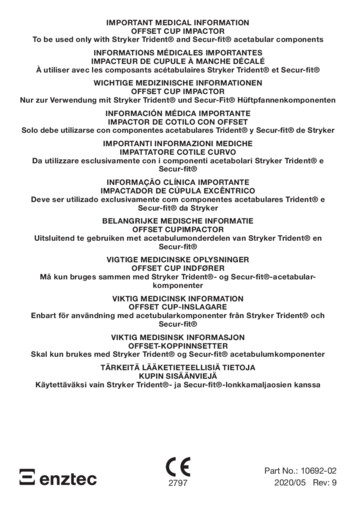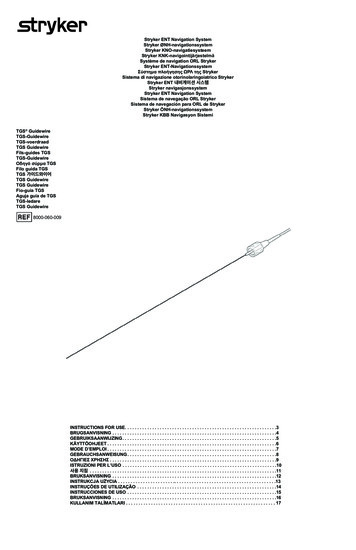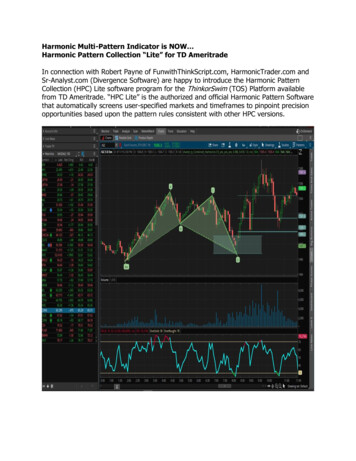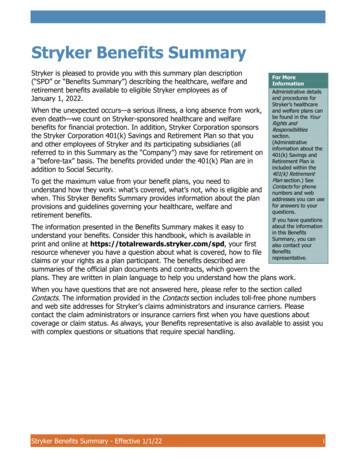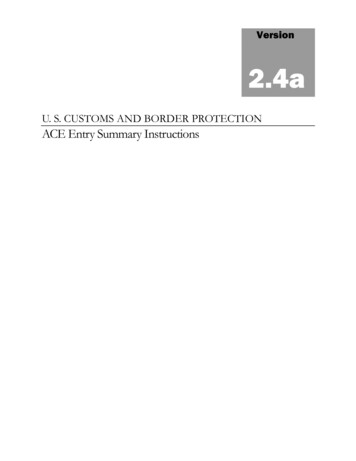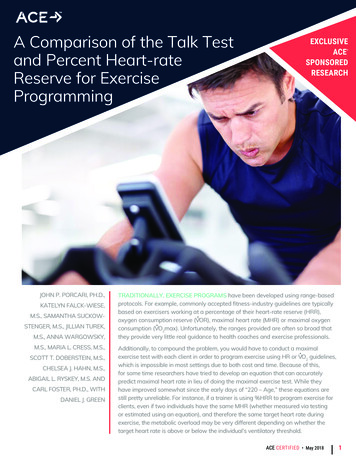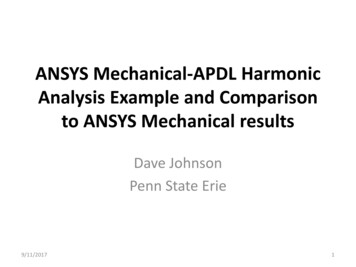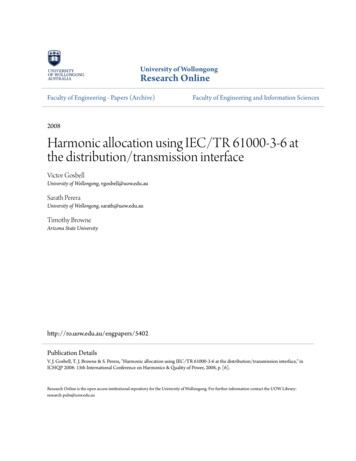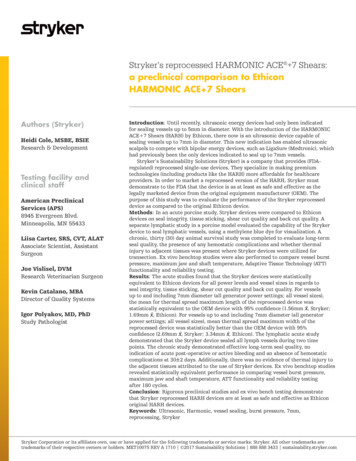
Transcription
Stryker’s reprocessed HARMONIC ACE 7 Shears:a preclinical comparison to EthiconHARMONIC ACE 7 ShearsAuthors (Stryker)Heidi Cole, MSBE, BSIEResearch & DevelopmentTesting facility andclinical staffAmerican PreclinicalServices (APS)8945 Evergreen Blvd.Minneapolis, MN 55433Liisa Carter, SRS, CVT, ALATAssociate Scientist, AssistantSurgeonJoe Vislisel, DVMResearch Veterinarian SurgeonKevin Catalano, MBADirector of Quality SystemsIgor Polyakov, MD, PhDStudy PathologistIntroduction: Until recently, ultrasonic energy devices had only been indicatedfor sealing vessels up to 5mm in diameter. With the introduction of the HARMONICACE 7 Shears (HARH) by Ethicon, there now is an ultrasonic device capable ofsealing vessels up to 7mm in diameter. This new indication has enabled ultrasonicscalpels to compete with bipolar energy devices, such as LigaSure (Medtronic), whichhad previously been the only devices indicated to seal up to 7mm vessels.Stryker’s Sustainability Solutions (Stryker) is a company that provides (FDAregulated) reprocessed single-use devices. They specialize in making premiumtechnologies (including products like the HARH) more affordable for healthcareproviders. In order to market a reprocessed version of the HARH, Stryker mustdemonstrate to the FDA that the device is as at least as safe and effective as thelegally marketed device from the original equipment manufacturer (OEM). Thepurpose of this study was to evaluate the performance of the Stryker reprocesseddevice as compared to the original Ethicon device.Methods: In an acute porcine study, Stryker devices were compared to Ethicondevices on seal integrity, tissue sticking, shear cut quality and back cut quality. Aseparate lymphatic study in a porcine model evaluated the capability of the Strykerdevice to seal lymphatic vessels, using a methylene blue dye for visualization. Achronic, thirty (30) day animal survival study was completed to evaluate long-termseal quality, the presence of any hemostatic complications and whether thermalinjury to adjacent tissues was present where Stryker devices were utilized fortransection. Ex vivo benchtop studies were also performed to compare vessel burstpressure, maximum jaw and shaft temperature, Adaptive Tissue Technology (ATT)functionality and reliability testing.Results: The acute studies found that the Stryker devices were statisticallyequivalent to Ethicon devices for all power levels and vessel sizes in regards toseal integrity, tissue sticking, shear cut quality and back cut quality. For vesselsup to and including 7mm diameter (all generator power settings; all vessel sizes),the mean for thermal spread maximum length of the reprocessed device wasstatistically equivalent to the OEM device with 95% confidence (1.56mm , Stryker;1.69mm , Ethicon). For vessels up to and including 7mm diameter (all generatorpower settings; all vessel sizes), mean thermal spread maximum width of thereprocessed device was statistically better than the OEM device with 95%confidence (2.69mm , Stryker; 3.34mm , Ethicon). The lymphatic acute studydemonstrated that the Stryker device sealed all lymph vessels during two timepoints. The chronic study demonstrated effective long-term seal quality, noindication of acute post-operative or active bleeding and an absence of hemostaticcomplications at 30 2 days. Additionally, there was no evidence of thermal injury tothe adjacent tissues attributed to the use of Stryker devices. Ex vivo benchtop studiesrevealed statistically equivalent performance in comparing vessel burst pressure,maximum jaw and shaft temperature, ATT functionality and reliability testingafter 180 cycles.Conclusion: Rigorous preclinical studies and ex vivo bench testing demonstratethat Stryker reprocessed HARH devices are at least as safe and effective as Ethiconoriginal HARH devices.Keywords: Ultrasonic, Harmonic, vessel sealing, burst pressure, 7mm,reprocessing, StrykerStryker Corporation or its affiliates own, use or have applied for the following trademarks or service marks: Stryker. All other trademarks aretrademarks of their respective owners or holders. MKT10075 REV A 1710 2017 Sustainability Solutions 888 888 3433 sustainability.stryker.com
Stryker’s reprocessed HARMONIC ACE 7 Shears:a preclinical comparison to EthiconHARMONIC ACE 7 ShearsReprocessing background:Reprocessing of single use devices (SUDs) is the practiceof cleaning, function testing, disinfecting (the process ofkilling pathogenic organisms or rendering them inert)and sterilizing products, per FDA regulation, so theycan safely be used again. Reprocessing of SUDs mayinclude disassembling devices down to their componentparts, repairing, refurbishing and reconstructing thedevice using only those components that have passedall inspections, and have demonstrated substantialequivalence through Premarket Notification, or 510(k)clearance, in accordance with the Food and DrugAdministration (FDA) Code of Federal Regulations(21CFR Part 807).1 The FDA has an establishedregulatory framework for the premarket review andpost market control of reprocessed SUDs, and 510(k)pre-market notification requirements for reprocesseddevices are at least as stringent as those enforced fororiginal equipment manufacturer (OEM) devices. Inaddition to the customary requirements of a 510(k)submission, FDA-registered reprocessing companiesmust also submit validation data regarding the cleaning,sterilization and performance of their devices. Thepractice has twice been evaluated by the United StatesGovernment Accountability Office (GAO), which statedin their most recent release that, “FDA oversight hasincreased, and available information does not indicatethat use [of reprocessed devices] presents an elevatedhealth risk.”2Stryker is the market-leading provider of single-usedevice reprocessing services. They have over a decade ofexperience reprocessing ultrasonic energy devices. Foreffective cleaning and the ability to conduct multi-pointinspections on each component, the Stryker reprocessedHARMONIC ACE 7 Shears (HARH) are disassembledto its base components. To ensure premium qualitystandards, Stryker will sometimes elect to replacecertain parts. In the case of the HARH, Stryker suppliesa newly designed tissue pad and recoats the cuttingblade with a non-stick coating. Once devices arereassembled, Stryker conducts simulated-use electricaltesting on Ethicon generators (GEN 11). To reject devicesnot fit for another use, Stryker performs multiplefunction tests on each device. Also of significance isthat Stryker has implemented the same quality systemStrykerHeidi Cole, MSBE, BSIEResearch & Developmentemployed within other divisions of Stryker. Strykerbelieves that their dedicated focus on quality is whatultimately drove the outcomes of a recent, independentstudy conducted at Banner Health where it wasreported that “Original equipment manufacturer devicesare nearly five times more likely to be defective thanreprocessed single-use devices.”3Methods:PreclinicalThe devices tested were Stryker reprocessed HARH andEthicon original HARH. The null hypothesis was definedas no difference in performance between reprocessedand OEM devices for acute, lymphatic and chronicstudies. The preclinical studies consisted of InstitutionalAnimal Care and Use Committee (IACUC) approvedprotocols using a porcine model.5 The anatomy andphysiology of the porcine cardiovascular model providesa vessel sealing and healing response similar to thatof humans. To eliminate bias, the surgeon, pathologistand clinical staff were blinded as to the deviceidentification (Stryker vs. Ethicon) until after all scoring,measurements and gross evaluation were completed.Acute animal studyThe acute animal study utilized six (6) animals—composed of three (3) subject animals (evaluatedwith Stryker reprocessed HARH) and three (3) controlanimals (evaluated with Ethicon HARH). Each animalhad one (1) HARH device utilized. The individualHARH devices each sealed between 20-24 vessels andcompleted 20 tissue dissections per animal. During thisstudy, each animal underwent a ventral laparotomy.Vessels of different sizes and with various physiologicalfunctions were targeted (Table 1). Device performancewas assessed through thermal damage measurement,seal integrity (hemostasis) at one (1) minute post-sealcompletion, tissue sticking to the device distal jawsand tissue dissection quality using the upper and lower(back-cutting) surfaces of the shears.Stryker Corporation or its affiliates own, use or have applied for the following trademarks or service marks: Stryker. All other trademarks aretrademarks of their respective owners or holders. MKT10075 REV A 1710 2017 Sustainability Solutions 888 888 3433 sustainability.stryker.com
Stryker’s reprocessed HARMONIC ACE 7 Shears:a preclinical comparison to EthiconHARMONIC ACE 7 ShearsVesseltypeStrykerHeidi Cole, MSBE, BSIEResearch & Developmentthose of the Ethicon HARH. The raw data and analysisare contained in the report on file.5Vessel identificationA/VbundleSplenic mesentery, gastrosplenic, shortgastric, right and left ovarian pedicle, bowelmesentery, uterine bundleArterySplenic, right and left renal, large intestinal,right and left carotidVeinSplenic, right and left renal, large intestinalTable 1. Targeted vessel type and identification.Thermal spread maximum length and width wereevaluated postoperatively by the study pathologist.Hematoxylin and eosin (H&E) were used for histologicalstaining. Thermal spread maximum length and widthwere identified by the pathologist per predeterminedcriteria. Morphometric analysis was performed bythe test facility’s morphometrist. A photomicrographof each vessel suitable for analysis was captured by adigital microscope camera attached to a microscope.Two types of measurements were made on each sealedvessel—the maximum length of thermal spread (depth,longitudinally along vessel) and the maximum widthof thermal spread (lateral spread). Seal integrity (at oneminute), tissue sticking and cut quality were rated on afour-tiered scale by the surgeon after performing eachincision†. For each evaluation, the median and modeof the ratings for the Stryker HARH were compared toLymphatic animal studyThe lymphatic animal study utilized one (1) porcineanimal that underwent multiple lymphatic vesselseals with a Stryker reprocessed HARH device. Five(5) mesenteric lymph vessels and bundles and thethoracic duct were sealed using the subject device. Themesenteric lymph nodes were injected with methyleneblue to stain the lymph fluid. The study surgeonevaluated each seal at one (1) minute and ten (10)minutes post-seal for seal integrity.Chronic animal studyThe chronic, 30-day survival study was designed toassess long-term seal quality and potential for injuryto adjacent structures. Multiple vessel types anddiameters were sealed using Stryker reprocessed HARHdevices on each power level (MIN, MAX and AH). Allthree generator power levels were represented in eachanimal. The power level was assigned based on vesseldiameter (1-7mm). Devices were used in accordancewith instructions for use (IFU) (Table 2). One Strykerreprocessed HARH device was used on each of the six (6)subject animals. There was also one (1) control porcineanimal where the Ethicon HARH was used. Each animalunderwent a splenectomy, unilateral nephrectomyand bilateral oophorectomy. A gross evaluation wasperformed at 30 2 days to assess hemostasis of thesealed vessels and any collateral tissue changes.MAX, Level 5(Maximum power level)MIN, Level 3(Minimum power level)Advanced Hemostasis(For large vessel sealing)Instructions for useTypically used forsmaller vessels wherecutting speed is fastestTypically used inslightly larger vesselsup to 5mm in size; hasreduced cutting speed(in comparison to MAX)Designed for largervessels up to 7mm in size;cutting speed is furtherreduced (in comparisonto MIN) and hemostasisis maximized.Approximate vessel diameter 0-2mm2-5mm5-7mmGenerator power level settingAdaptive Tissue Technology (ATT) is utilized across all settings, which provides the generator with the ability to identifyand monitor the instrument during use by modulating and adjusting power output during use (in addition to providingaudible feedback to the user).Table 2. Generator power level assignment per vessel diameter.Stryker Corporation or its affiliates own, use or have applied for the following trademarks or service marks: Stryker. All other trademarks aretrademarks of their respective owners or holders. MKT10075 REV A 1710 2017 Sustainability Solutions 888 888 3433 sustainability.stryker.com
Stryker’s reprocessed HARMONIC ACE 7 Shears:a preclinical comparison to EthiconHARMONIC ACE 7 ShearsStrykerHeidi Cole, MSBE, BSIEResearch & DevelopmentBenchtop studies(MIN, MAX and AH) for Stryker devices after 180activation cycles.Ex vivo benchtop studies were also performed tocompare vessel burst pressure, maximum jaw and shafttemperature, ATT functionality and reliability testing.†The 4-tiered scale used for each evaluation is as follows:Seal integrity: 1 “Seal at tissue site, no leakage of blood(complete hemostasis)”; 2 “Seal at tissue site, slight oozing of bloodBurst pressurethat stops within ( ) 1 min.”; 3 “Partial sealing of vessel, briskBenchtop burst pressure testing evaluated the strengthof transected 2-7mm diameter porcine carotid and iliacarteries using Stryker and Ethicon devices. During thistesting, previously sealed vessels were infused withsaline until they ruptured. Before the vessel burst, themaximum internal vessel pressure was determinedusing a customized fixture and pressure gauge. Thirty(30) vessels were tested for each of the three (3) powersettings (MIN, MAX and AH).bleeding present that requires intervention”; 4 “Incomplete sealingwith uncontrolled bleeding requiring intervention”.Tissue sticking: 1 “No sticking, tissue falls off instrument whenopened”; 2 “Tissue sticking, minor adherence to one or both jaws”;3 “Tissue sticking requiring counter tension and extensive force toremove tissue”; 4 “Tissue sticking such that tissue is damaged ortorn during the removal process”.Shear and back cut quality: 1 “Exceeds expectations inestablishing dissection plane”; 2 “Adequately establishes dissectionplane”; 3 “Requires excessive force/repeated attempts to establishMaximum jaw and shaft temperatureMaximum temperature of the jaw and shaft wasmeasured utilizing a calibrated forward looking infrared(FLIR) camera to capture a video of the surgical deviceduring activation and tissue transection. Videos wereanalyzed using a custom MATLAB software, which readtemperature data and reported maximum temperaturesattained in Regions of Interest (ROI) specified by theuser. Thirty (30) porcine carotid arteries (2-7mmdiameter) were tested for each of the three (3) powersettings (MIN, MAX and AH) for Stryker andEthicon devices.ATT functionalityATT)functionality test demonstrated the timedifference between vessel transection and audible tonechange (ATT tone). Thirty (30) porcine carotid arteries(2-7mm diameter) were tested for each of the three (3)power settings (MIN, MAX and AH) for Stryker andEthicon devices.Reliability testingReliability testing evaluated the preservation of Strykerreprocessed device functionality after 180 activationcycles. Thirty (30) porcine carotid arteries (2-7mmdiameter) were tested for each of the three (3) powersettings (MIN, MAX and AH) for Stryker and Ethicondevices as the first cycle baseline measurement. Twentytwo (22) porcine carotid arteries (2-7mm diameter) weretested for each of the three (3) power settingsdissection plane”; 4 “Failure to establish dissection plane”.Results:Acute animal studyThermal spread: For vessels up to and including7mm diameter (all generator power settings;all vessel sizes), mean thermal spread maximum lengthof the Stryker reprocessed device was statisticallyequivalent to the Ethicon device with 95% confidence(1.56mm , Stryker; 1.69mm , Ethicon). For vesselsup to and including 7mm diameter (all generatorpower settings; all vessel sizes), mean thermal spreadmaximum width of Stryker reprocessed device wasstatistically better than the Ethicon device with 95%confidence (2.69mm , Stryker; 3.34mm , Ethicon).A P-value of 0.045 indicates a detectable statisticaldifference between the thermal spread maximumwidth in the two populations, with the thermal spreadmaximum width of the Stryker reprocessed device beingstatistically less than the Ethicon device. See Tables3 and 4 for detailed results per vessel size range andgenerator power levels.Stryker Corporation or its affiliates own, use or have applied for the following trademarks or service marks: Stryker. All other trademarks aretrademarks of their respective owners or holders. MKT10075 REV A 1710 2017 Sustainability Solutions 888 888 3433 sustainability.stryker.com
Stryker’s reprocessed HARMONIC ACE 7 Shears:a preclinical comparison to EthiconHARMONIC ACE 7 ShearsStrykerHeidi Cole, MSBE, BSIEResearch & DevelopmentStryker HARH36Ethicon HARH36Vessel sizerangeGeneratorpowerMean (mm)SD (mm)NMean (mm)SD .79190.9420-7mmAll levels1.560.84561.690.81500.382Table 3. thermal spread maximum length results summary.Stryker HARH36Ethicon HARH36Vessel sizerangeGeneratorpowerMean (mm)SD (mm)NMean (mm)SD .55190.0350-7mmAll levels2.691.29563.341.92500.045Table 4. Thermal spread maximum width results summary.Figure 2 shows representative morphometric evaluation for the Stryker and Ethicon device seals.EthiconStrykerFigure 2. Representative histological images of 5mm renal arteries sealed with AH power level utilizing an Ethicon device (left) and a Strykerdevice (right).Stryker Corporation or its affiliates own, use or have applied for the following trademarks or service marks: Stryker. All other trademarks aretrademarks of their respective owners or holders. MKT10075 REV A 1710 2017 Sustainability Solutions 888 888 3433 sustainability.stryker.com
Stryker’s reprocessed HARMONIC ACE 7 Shears:a preclinical comparison to EthiconHARMONIC ACE 7 ShearsSeal integrity: Sixty-eight (68) samples from eachgroup were evaluated by the surgeon for seal integrity.Seal integrity was recorded at one (1) minute. Overallmedian and mode seal integrity ratings for both Strykerreprocessed HARH and Ethicon HARH were one (1),indicating adequate seal at tissue site, with no leakageof blood (complete hemostasis). There was no detectablestatistical difference between the groups for the timeinterval (Table 5). During microscopic examination(post-operatively by the pathologist), all acutelycollected blood vessels (arteries, veins and AV bundles)from the test and control sites demonstrated similarhistopathologic changes at the edge of the seal in thecoagulation zone and appeared to have good microscopicseal integrity. In addition, there was no evidence ofhemorrhage on the ends of the seals for either subject orcontrol seal sites (Stryker or Ethicon).Tissue sticking: Sixty-eight (68) Stryker reprocessedHARH and sixty-eight (68) Ethicon HARH wereevaluated for tissue sticking. Overall median andmode tissue sticking ratings by the surgeon, for bothgroups, were one (1), indicating “no sticking, tissue fallsoff instrument when opened,” according to the preestablished ranking scale.†StrykerHeidi Cole, MSBE, BSIEResearch & DevelopmentShear cutqualityBack cutqualityStrykerN 3022EthiconN 3022StrykerN 3022EthiconN 3022Table 5. Surgeon-rated results for seal integrity, tissue sticking, shearcut quality and back cut quality according to the pre-establishedranking scale.†Lymphatic animal studyFor the thoracic duct and all mesenteric lymphvessels, the surgeon visually confirmed no leakageat 1 minute and 10 minutes post-transection for theStryker reprocessed HARH device. Figure 3 shows anintricate mesenteric lymph vessel bundle (injected withmethylene blue dye) that was effectively sealed with theStryker reprocessed HARH device.Dissection/Cut quality: Sixty (60) samples fromeach group were evaluated for dissection/cut quality.Thirty (30) samples were evaluated for shear dissection/cut quality and thirty (30) for back cut dissection/cutquality. Overall median and mode cut quality ratingsfor both Stryker reprocessed HARH and Ethicon HARHwere two (2) for each dissection/cut method. Thisindicated that each shear cut and back cut “adequatelyestablished dissection plane,” as evaluated by thesurgeon according to the pre-established ranking scale.†Figure 3. Mesenteric lymph vessel bundle sealed by a cetypeNumberof datapointsMedianratingModeratingStrykerN 6811EthiconN 6811StrykerN 6811EthiconN 6811Stryker HARH device.Chronic animal studyFor the six (6) subject animals totaling seventy-one(71) seal sites, there were no hemostatic complicationsattributed to the reprocessed device as noted by thepathologist at 30 2 day necropsy. A control animalwith 14 seal sites was also evaluated. The pathologicalgross assessment of the subject animals demonstratedhealed vascular seal sites with acceptable long-term sealquality and no indication of recent or active bleeding.Stryker Corporation or its affiliates own, use or have applied for the following trademarks or service marks: Stryker. All other trademarks aretrademarks of their respective owners or holders. MKT10075 REV A 1710 2017 Sustainability Solutions 888 888 3433 sustainability.stryker.com
Stryker’s reprocessed HARMONIC ACE 7 Shears:a preclinical comparison to EthiconHARMONIC ACE 7 ShearsStrykerHeidi Cole, MSBE, BSIEResearch & DevelopmentHistogram of vessel OD (mm)NormalOEM, pre-reliability, MAXOEM, pre-reliability, AHOEM, pre-reliability, MIN105Frequency0Stryker, post-reliability, MAXStryker, post-reliability, MINStryker, post-reliability, AHStryker, pre-reliability, MAXStryker, pre-reliability, MINStryker, pre-reliability, 04.753.003.25752.6.006.255.504.753.003.2.250Vessel OD (mm)Figure 4. The porcine arteries utilized for burst pressure testing spanned the entire range of indicated vessel size and energy setting combinations.In addition, there were no hemostatic complicationsor evidence of thermal injury to adjacent tissueattributed to use of the Stryker reprocessed HARHdevice. The chronic study provides further assurancethat the Stryker reprocessed HARH device will provideacceptable long-term seal quality.Benchtop studiesMaximum jaw and shaft temperatureThe maximum jaw and shaft temperature of Strykerreprocessed HARH devices was statistically equivalentto the temperature of the Ethicon HARH jaw and shaftfor all three (3) power settings (MIN, MAX and AH).Figure 5 shows a representative image of how thethermal profile was captured by the FLIR camera duringporcine carotid artery transection.Burst pressureFigure 5. FLIR imageThe burst pressure strength of sealed porcine carotidand iliac arteries using Stryker reprocessed devices wasstatistically equivalent to the burst pressure strengthof the Ethicon devices for all three (3) power settings(MIN, MAX and AH). The burst pressure for all subjectseals exceeded the clinically important burst pressurethreshold for hemostasis of 240 mmHg (4.64psi). Figure4 (Pre-reliability charts) shows the carotid and iliacartery diameter distribution utilized for testing at eachpower level.of HARH jaw and shaftduring porcine carotidartery transection.Stryker Corporation or its affiliates own, use or have applied for the following trademarks or service marks: Stryker. All other trademarks aretrademarks of their respective owners or holders. MKT10075 REV A 1710 2017 Sustainability Solutions 888 888 3433 sustainability.stryker.com
Stryker’s reprocessed HARMONIC ACE 7 Shears:a preclinical comparison to EthiconHARMONIC ACE 7 ShearsStrykerHeidi Cole, MSBE, BSIEResearch & DevelopmentATT functionalitytissue sticking to the blade and excessive activationtimes, the flow of heat follows a thermal gradient as itmoves from the device to the tissue.7The difference between the transection time and audibletone change (ATT tone) for vessel seals performed byStryker reprocessed HARH devices was statisticallyequivalent to the time difference of the Ethicon devicesfor all three (3) power settings (MIN, MAX and AH).Reliability testingReliability testing for burst pressure strength of sealedporcine carotid arteries after the 180th activation cyclewas statistically equivalent to the first cycle for Strykerreprocessed HARH devices for all three (3) powersettings (MIN, MAX and AH). The burst pressure for allsubject seals exceeded the clinically important burstpressure threshold for hemostasis of 240 mmHg (4.64psi)after 180 cycles. Figure 4 (Post-Reliability charts) showsthe carotid and artery diameter distribution utilized forburst pressure testing after the 180th cycle.In addition, maximum jaw and shaft temperatures atthe 180th activation cycle for Stryker reprocessed HARHdevices were statistically equivalent to the first cyclefor Ethicon devices for all three (3) power settings (MIN,MAX and AH).Discussion:Stryker’s predecessor companies first beganreprocessing ultrasonic sealing devices in 2005.6 Morerecently, this technology has seen rapid advances fromoriginal manufacturers. In 2012, Ethicon introducedATT.6 ATT uses a proprietary set of algorithms tosense and respond to changes in tissue conditions.7This innovation has been credited with deliveringincreased seal strengths and faster cutting times atlower device peak temperatures.7 This is importantbecause ultrasonic device temperatures can rapidlyincrease when the blade of the device is activated onthe tissue pad.7 With ATT, the power level is reducedwhen transection is near completion, which aids inthe “thermal management” of the blade.7 Also worthmentioning is that, with ultrasonic devices, thetemperature of the device is generally not the same asthe temperature of the tissue. Essentially, even whendevice temperatures are significantly higher thannormal due to, amongst other factors, tissue conditions,In 2013, Ethicon incorporated AH within their ATT.6AH leverages “predictive analytics within the ATTalgorithms to modulate the delivery of energy totissue.”7 AH receives multiple inputs from the generatorthat enables this feature to monitor tissue during 3stages: preheating, vessel sealing and transection.7While commonly known that heat, compression andtime are the primary factors in how thermal seals areformed, AH has enabled a more specific understandingof the interplay between those factors.7 Studies byEthicon have concluded that, “in general, longer sealingtimes correspond to higher burst pressures and morereliable sealing.”7 That being the case, heat over timeand compression over time would now seem to be thetwo main components of thermal seal formation. Thesedevelopments have contributed to Ethicon now beingable to market the first 7mm vessel sealing indicationon an ultrasonic device. While the 7mm indication is apotential breakthrough for ultrasonic technology, it isimportant to offer additional context. As pointed out byEthicon, “surgeons rarely, if ever, seal 6-7mm vesselswith any energy device.”7 The main benefit of AH, then,might be its ability to increase the confidence and safetymargin of having a secure seal when it matters most.7Stryker-sponsored acute, lymphatic and chronic GLPanimal studies, as well as rigorous benchtop testingdemonstrate that Stryker reprocessed HARH devicesperform at least as effectively as Ethicon’s HARHdevices. The parameters measured included sealintegrity, tissue sticking, tissue cut quality, thermalspread, burst pressure, maximum jaw and shafttemperature, ATT functionality, long-term seal qualityand reliability testing. As mentioned above, certainfactors drive parallel device performance betweenStryker and Ethicon devices. One factor being the(GEN 11) generator, as opposed to the actual device,modulating the ATT and AH functionality. Anotherfactor is the same reusable handpiece used on bothEthicon and Stryker devices. Electrical energy isconverted to mechanical energy in the handpiecevia piezoelectric crystal. Mechanical power from thehandpiece is therefore restricted by the electricalStryker Corporation or its affiliates own, use or have applied for the following trademarks or service marks: Stryker. All other trademarks aretrademarks of their respective owners or holders. MKT10075 REV A 1710 2017 Sustainability Solutions 888 888 3433 sustainability.stryker.com
Stryker’s reprocessed HARMONIC ACE 7 Shears:a preclinical comparison to EthiconHARMONIC ACE 7 ShearsStrykerHeidi Cole, MSBE, BSIEResearch & Developmentcurrent flowing from the generator. Relatedly, the poweroutput to the activation buttons (MIN, MAX and AH) isalso controlled by the generator. Other factors in deviceperformance are the steps Stryker takes in reprocessingtheir harmonic scalpels. To reduce tissue sticking,Stryker re-coats the cutting blade with a non-stickcoating. This update was first introduced in the previousgeneration (HAR) harmonic scalpel. To help minimizethermal spread, Stryker redesigned their own tissuepad, which they replace on each device.These additional requirements might help explain thefavorable performance reported within the real world,“defect rate” analysis.Arguably the most important measure of performanceis real world application. In a previously publishedstudy, it was reported that OEM vessel sealing devices“were found to be defective 4.9 times more frequentlythan” reprocessed devices.3 This study was actuallya retrospective review of defects as reported by asurgical team, during live procedures, over a sevenmonth period.3 Over 1,700 ultrasonic devices, bothOEM and reprocessed, comprised the sample size.3Un
Stryker's Sustainability Solutions (Stryker) is a company that provides (FDA-regulated) reprocessed single-use devices. They specialize in making premium technologies (including products like the HARH) more affordable for healthcare providers. In order to market a reprocessed version of the HARH, Stryker must
